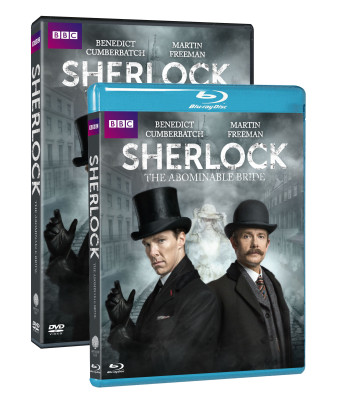
From the day that Sherlock premiered, there some fans, like me, who wondered how series creators Mark Gatiss and Steven Moffat would handle a more traditional, Victorian adventure featuring the Great Detective.
Now we know (kind of) and the verdict is: wonderfully!
The Abominable Bride is a great mystery from concept to execution: a man is murdered by his wife – who was seen to have loudly and publicly committed suicide hours earlier! Of course, nothing (and I mean nothing) is as it seems – to an even greater extent than we’ve seen on the regular series – so when another man is threatened by the same, dead, woman…
Among The Abominable Bride’s many delights are the first meeting of Holmes and Watson – as described by Sir Arthur Conan Doyle (a sequence that neither Gatiss nor Moffat recall ever being committed to film before); the sight of the corpulent Mycroft Holmes as described by Doyle – a delicate chap who would make Nero Wolfe look skinny; an ingenious way to weave Mary Watson (née Morstan into the story); an oddly familiar medical examiner, and Mrs. Hudson’s disapproval of Watson’s stories in the Strand Magazine.
The mechanics of the actual mystery are ingenious and just odd enough to feel like a canonical supernatural-but-not-really situation; Holmes’ Victorian mind palace is both incredibly funny and perfect for the era (though that’s not the half of it), and we even get Holmes and Moriarty at the Reichenbach Falls.
In and around the events of The Abominable Bride, we also get to see what it might look like if Sherlock Holmes were to have an existential crisis – and a use for the infamous 7% solution other than to relieve boredom between cases.
There are moments when writers Gatiss and Moffat almost seem to be taking the mickey out of themselves; their script is cheekier and more melodramatic than I was expecting (see: deerstalker and Inverness; allusions to other Holmes cases, canonical and otherwise) – neither of which is a fault.
It should go without saying (but won’t) that Benedict Cumberbatch, Martin Freeman, Una Stubbs, Amanda Abbington, Mark Gatiss, Rupert Graves and Andrew Scott are all in tip-top form throughout and director Douglas Mackinnon brings together all the elements of a Sherlock episode and makes them feel at home in Victorian England – The Abominable Bride is both cozier and warmer than what we’re used to getting from the series, but familiar enough that it works.
As I do not wish to give spoilers to anyone who wishes to obtain The Abominable Bride on home video but has yet to have seen the adventure, I cannot satisfactorily explain the possible existential crisis, but it will become apparent on viewing. Without saying anything more, I can say that The Abominable Bride (I love the very Hammer Films-ness of the title) is quite possibly the best episode of Sherlock to date. It is, indeed special.
Bonus features include: Mark Gatiss: A Study in Sherlock – a thirty-minute featurette examining the series to date, including The Abominable Bride, and what it means to be doing a special one-off that at once radically departs from and strictly adheres to the conventions of Sherlock; Mark Gatiss: Production Diary – a five-minute featurette that follows Gatiss through one specific and unique day of the production; Creating the Look – a half-hour featurette that takes us behind the scenes to see how various key elements of the special – costuming, locations, effects, etc. – were achieved; Writers Interview – about four minutes of Gatiss and Moffat wallowing (deservedly) in the giddiness they experienced in the conception and execution of this one-off, and Sherlockology – twenty minutes of interviews with Amanda Abbington (Mary Watson), Una Stubbs (Mrs. Hudson), David Nellist (Mike Stamford), Sue Vertue (producer) and Steven Moffat (co-writer/co-creator).
Grade: Sherlock: The Abominable Bride – A+
Grade: Features – A
Final Grade: A